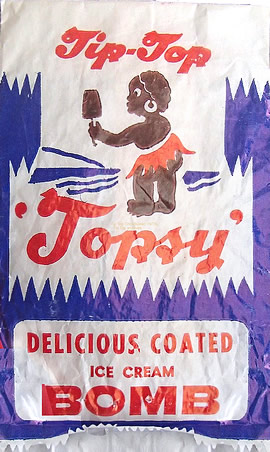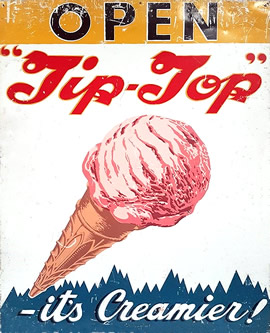The History of Ice
Cream in New Zealand
By Chris Newey

Tip Top
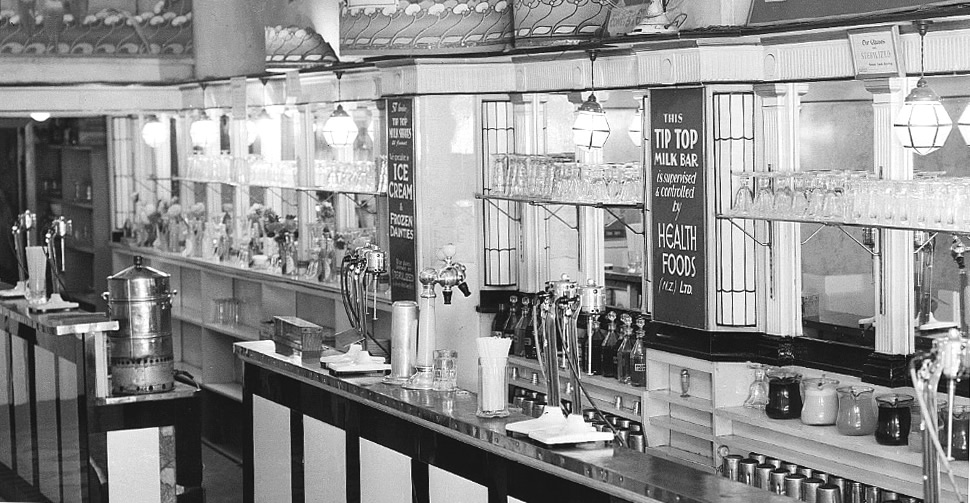
Tip Top Milk Bar, Courtenay Place, Wellington, ca. 1936
- Dominion Post.
Leonard Aloysius Patrick (Len) Malaghan was born
in Queenstown on 18 February 1906.
His business instincts were soon evident - at the age of ten, with money
he had earned from gathering and selling cocksfoot grass seed, he purchased
a cow, which he proudly drove home down the main street of Tapanui. By
age 13 he owned five cows, milking them twice a day (before and after
school) and selling the milk to the local cheese factory.
Len left school at age 14 to work as a cheese and butter-maker at the
Tapanui Co-Operative Dairy Co.. By 16 he was a second assistant, by seventeen
a qualified cheesemaker. By the age of 18, he had qualified as a dairy
factory manager (the youngest person in the country with Grade Notes
at the time).
Hungry for experience, he moved to Dunedin to work for the Taieri & Peninsula
Milk Supply Company which had both butter and milk supply operations.
While there he worked in every department, including the laboratory,
and applied for a patent for a butter-making device he invented.
In 1926 he applied for a senior position with the Dairy Division of the
Department of Agriculture, but at 20 he was considered too young. Instead
he was given the opportunity to train in ice cream production under an
American expert, a Mr Munro, at Frozen Products Ltd (Frosty
Jack brand) in Wellington. After a season there he returned
to Dunedin and worked under another American, a Mr van Every, at Crystal
Ice Cream for about three years.
In 1931, Len left Crystal with the idea of starting his own business,
however he was offered a position with the Dunedin Ice Cream
Manufacturing Company (Royal Ice Cream brand)
as ice cream maker and Manager. Len was at Royal for four years, developing
a new ice cream formulation and a bottled cream delivery business. With
surplus cream, the company set out to investigate butter production and
in 1933 Len went on a trip around the North Island to purchase machinery.
To cover expenses, he demonstrated at ice cream factories the manufacture
and decorating of ice cream cakes with fresh cream. In Auckland, he was
approached with a proposition to start ice cream manufacture in the Hygienic
Dairy Company factory in Epsom, but being committed in Dunedin, was unable
to accept.
Around this time, he went into a highly profitable venture to make milk
ice blocks with a Mr Waddington of Arctic Ice Cream Co.,
Petone, selling the recipe and method of manufacture to ice cream manufacturers
throughout New Zealand.
Len had become friends with Albert Edward (Bert) Hayman,
one of Royal's customers, who owned the Sunshine Milk Bar in the Octagon
in Dunedin. The milk bar was a new concept, following American trends,
selling healthy milk-based drinks, both hot and chilled, usually along
with soup, sandwiches and other snacks.
In 1935 Len and Bert decided to go into partnership to start a new type
of milk bar business, focussing on ice cream and milk shakes. They chose
Wellington as the location.
On their way up to Wellington, Len and Bert had discussed their plans
with a mutual friend, the manager of the Oamaru Railway Refreshment Rooms.
His response was "Why, that's Tip-Top", and an ice cream brand name was
born.
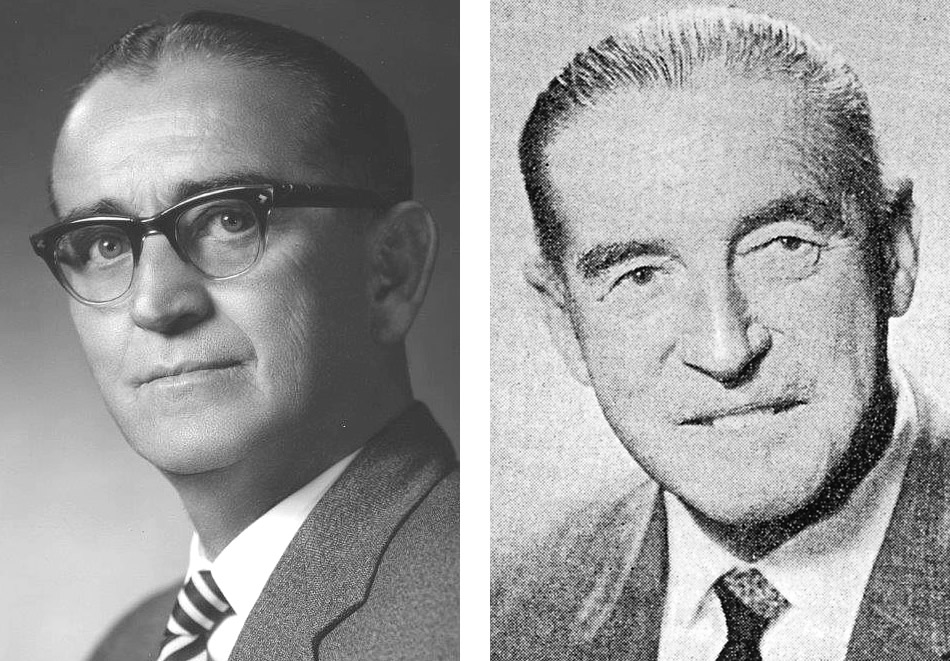
Len Malaghan and Bert Hayman in later years.
On their first day in Wellington they selected a
shop in Manners St, so confident in the concept that they entered into
a 10-year lease at an annual rental almost equal to their total capital, £750,
a brave move in the midst of the Great Depression.
The name of the new business was Health Foods, Ltd and
their ice cream brand was to be "TIP TOP".
On the day he left Dunedin to move to Wellington, Len married Ann,
his partner for this venture and many more.
The shop fit-out took about six weeks, using the red, white and blue
colour scheme that would become synonomous with the brand.
On the 10th of October 1935 the new milk bar at 36 Manners
St, in central Wellington, was officially opened by J. A. Murdoch, Minister
of Agriculture and Chairman of the Dairy Control Board, ensuring that
the new venture received plenty of publicity:
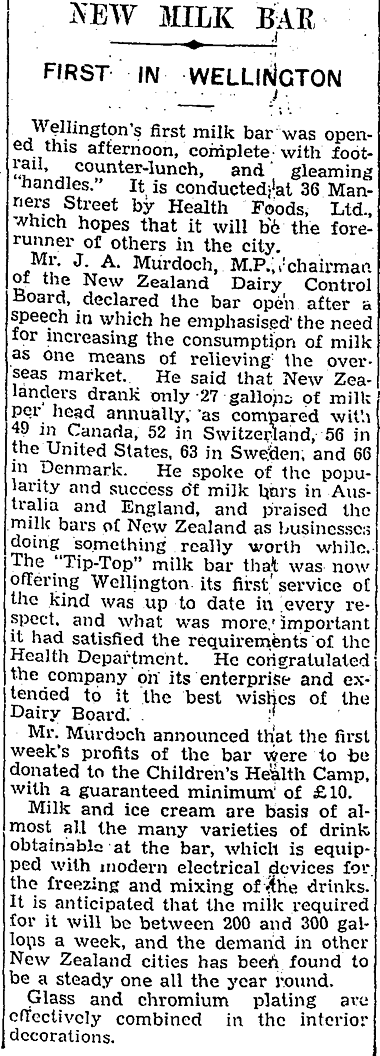
- Evening Post, 10 October 1935.
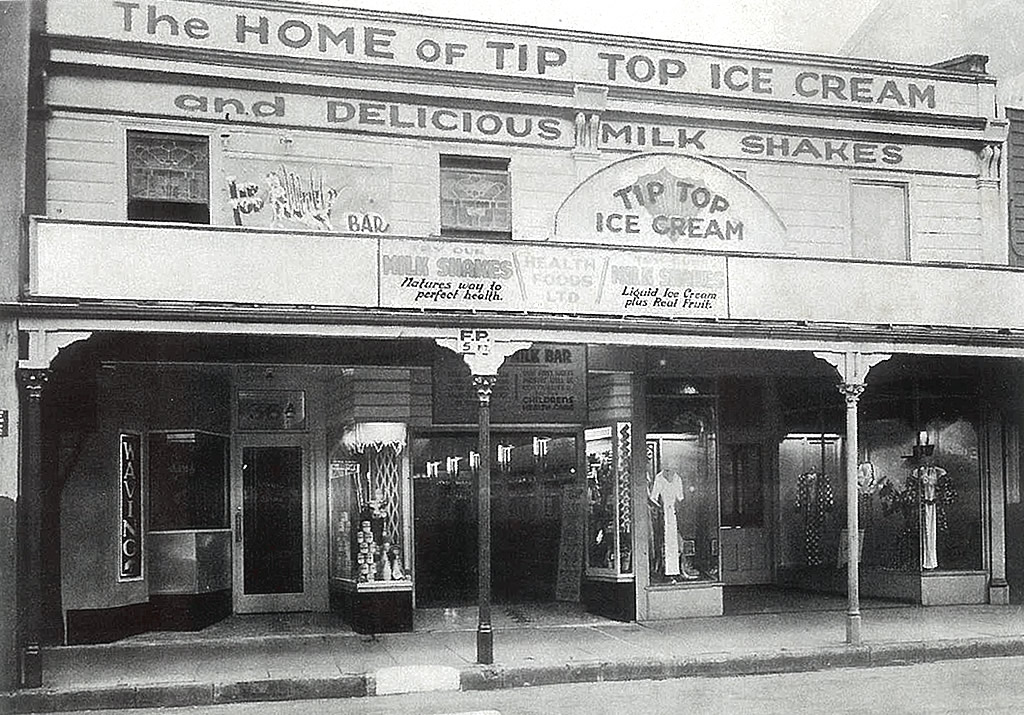
The original Tip Top milk bar, 36 Manners St, Wellington, 1935.
- The Early Tip Top Story, Tip Top archives
Emerging from the Depression years, milk and dairy
products were seen as having excellent food value. Ice cream and milkshakes
were seen as a nutritious treats for adults, not so much the younger
market that we associate milk bars with these days.
Milkshakes, priced 4d and 6d, were
enjoyed both hot and cold, made with a wide range of Tip Top's own
syrup-based flavours.
Popular hot flavours included Bournvita,
Caramel, Chocolate, Coffee,
Cinnamon, Honey & Malt, Malted Milk, Milo,
Ovaltine and Whiskey.
Cold flavours included the usual fruits, but also some not so familiar these
days;
Caramel Yeast,
Cinnamon, Coffee, Creaming Soda, Creme de Menthe, Kola, Ovaltine, Rum
&
Raspberry, Sarsparilla and Honey & Rum.
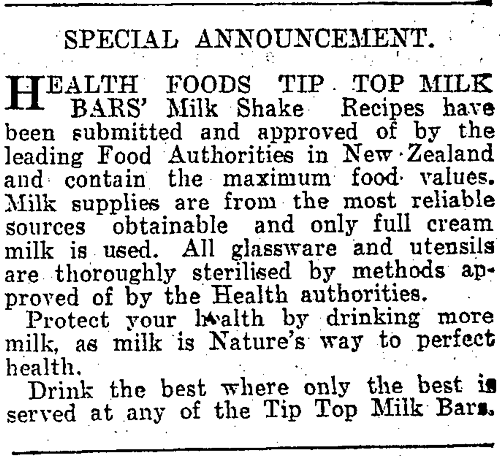
Health Foods Tip Top Milk Bars advert,
Evening Post, 19 December 1936
Bert's Dunedin commitments meant that Len became
the active partner in the Manners St. business, the success of which
quickly led to expansion. A second Tip Top Milk Bar was opened on Lambton
Quay in March 1936, managed by Bert's brother Gordon Hayman and
his wife.
In May 1936, they registered a new company, Health Foods New
Zealand, with a capital of £15,000, to acquire the Wellington
shops and Bert's shop in Dunedin, and to expand their milk bars into
other areas.
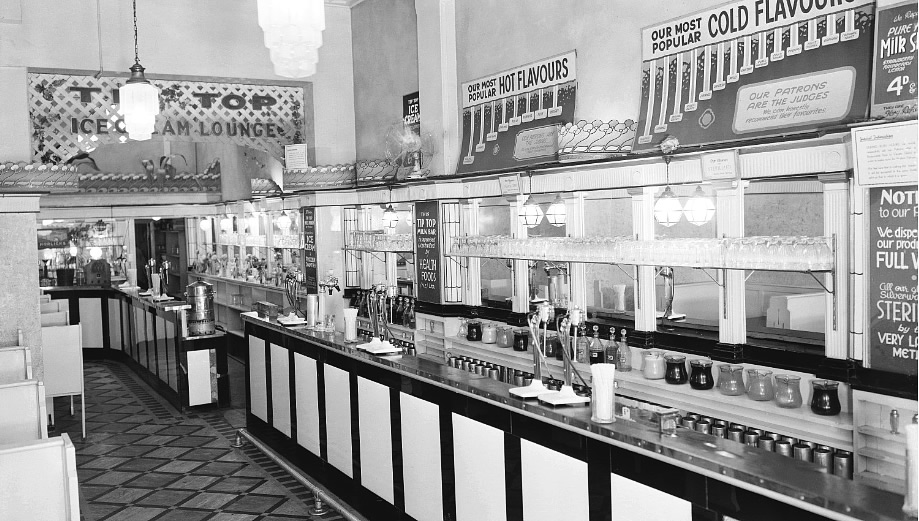
Tip Top Milk Bar, Courtenay Place, Wellington, ca. 1936
- Dominion Post.
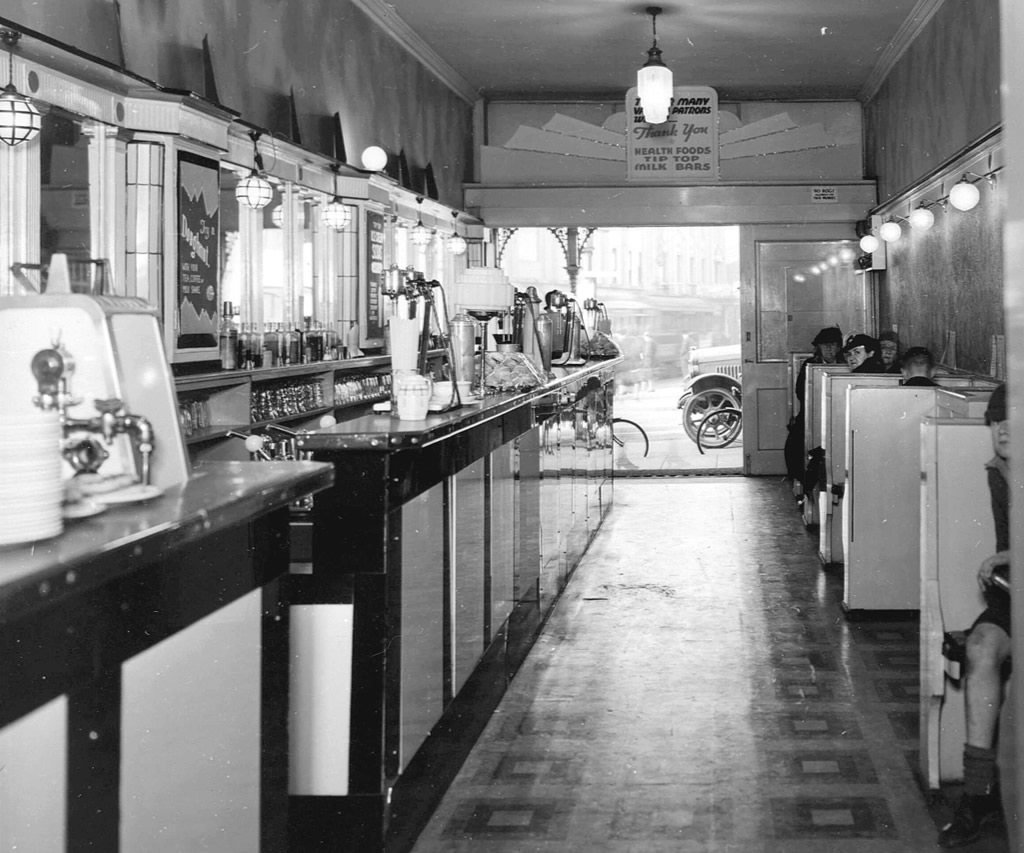
Interior view of the Tip Top Milk Bar on the corner of Manners
and Cuba Streets, ca. 1936
- Alexander Turnbull Library Ref: 1/1-015556-F.
Tip Top milk bars were opened in Eastbourne, Upper
Hutt (1937), Blenheim, and around the lower North Island.
The Sunshine Milk Bar in Nelson acquired the "Tip Top agency" for
Nelson Districts in 1936. The Sunshine's counter and buffet share several
design elements in common with the Wellington Tip Top Milk Bars, suggesting
that a standardised Tip Top Milk Bar fit-out was part of the franchise
arrangement.
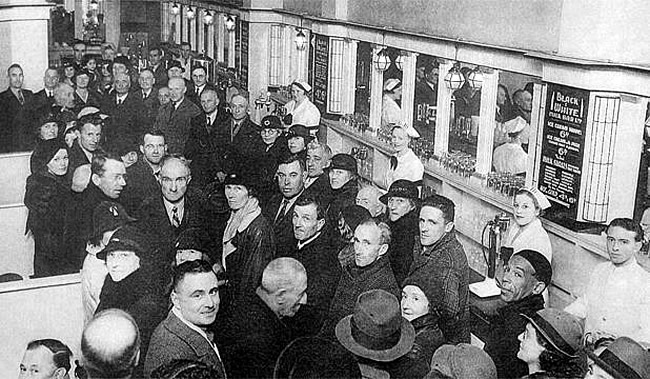
Black & White Milk Bar opening, 64 Willis St., Wellington,
11 June 1936
- Dominion Post.
The Black & White Milk Bar had opened a second shop
at 64 Willis St, Wellington, on the 11th of June 1936, and this was
possibly another Tip Top "agency" - a photo of the opening
function (above) shows almost identical panelling and light fittings.
Both
Black & White Milk Bars were taken over by Health Foods in 1937. By December
that year there were five Health Foods (NZ)-operated Tip Top Milk Bars in central
Wellington, two of them in Cuba St. The Tip Top Milk Bar chain would eventually
grow to twenty shops.
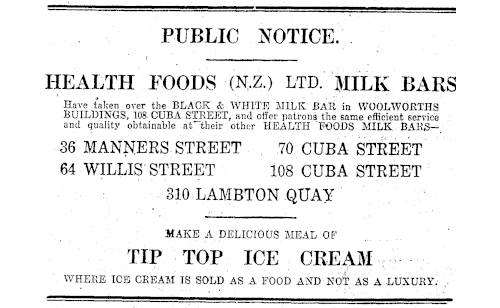
Health Foods (NZ) Ltd. Tip Top Milk Bars advertisement,
Evening Post, 11 December 1937
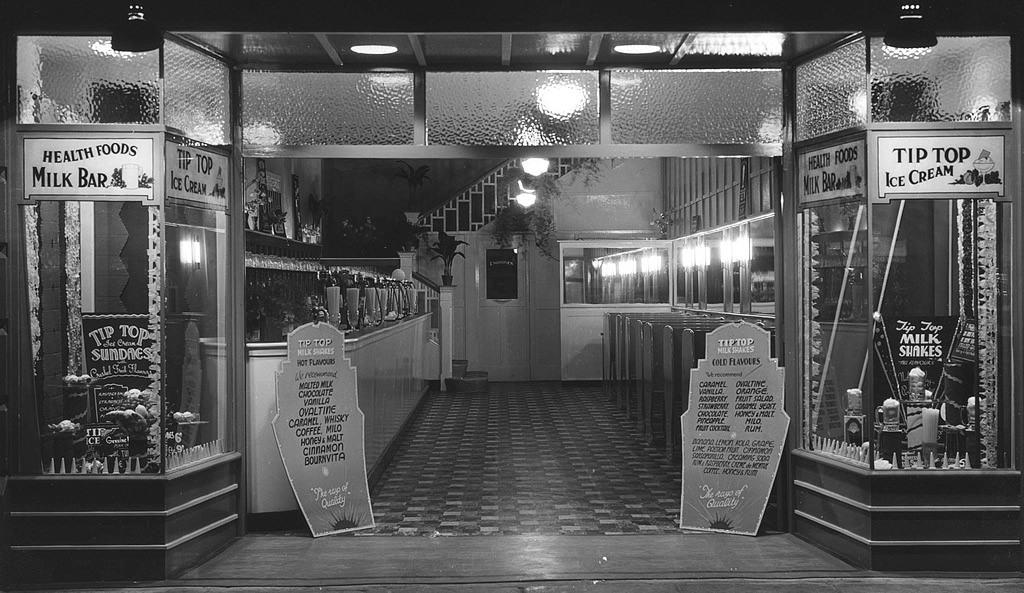
Above and below: Exterior and interior views of a Health Foods
Tip Top Milk Bar, either Hastings or Napier, 1937-38.
- Knowledge Bank.

For the first year of business, "TIP TOP" ice cream
had been supplied to Health Foods' milk bars by the Dunedin Ice Cream
Manufacturing Co.. On leaving the company, Len had been due payment
for the ice cream formula that he had developed while working there
- instead, he negotiated a supply of ice cream at a reduced cost, for
one year.
This was quite a logistical achievement for the time - freighting ice
cream from Dunedin to Wellington, by refrigerated ship. On arrival it
was stored at the Co-operative Dairy Producers Freezing Co. Ltd's cool
stores on Waterloo Quay in central Wellington.
By the end of that first year, they were ready to make their own ice
cream. Bert sold his Dunedin shop and made the move to Wellington, to
take a more active role in the business.
In July 1936 the Tip Top Ice Cream Company was
registered as a manufacturing company, to supply Health Foods (NZ) with
ice cream, and some time later, Tip Top opened its own factory at rented
premises on the site of the Co-operative Dairy Producers Freezing Co.
Ltd's cool stores on Waterloo Quay in central Wellington. The freezing
stores business, primarily involved in storing export cheese and butter,
provided refrigeration and steam, and leased factory space to Tip Top
at £10 per week.
Len Malaghan made sure that the new factory had the very latest equipment,
including a number of "firsts" for New Zealand - the first
Vogt continuous freezer; the first direct expansion holding vats; the
first vehicle with its own refrigeration unit installed; the first refrigerated
articulated vehicle.
In 1926 Clarence Vogt of Louisville, Kentucky had developed and patented
a continuous, scraped-surface freezer ("Votator"), which revolutionised
the ice cream industry, opening the way for true mass production. Tip
Top became the first company in New Zealand to employ the new "instant" freezing
technology:

Willow Milk Bar advertisement, Hutt News, 24 May 1939
By 1938, Tip Top Milk Bars were operating successfully all around the
lower North Island, Nelson and Blenheim, with average per shop ice
cream sales around 9000 gallons a year. Bert and Len began to think
about the giant Auckland market, where the climate was even more suitable
for the ice cream trade.
May 1938 - Tip Top Ice
Cream Company Auckland Limited was launched,
with Tip Top Ice Cream Company (Wellington), Health
Foods (New Zealand) Ltd, Bert Hayman and Len Malaghan
as major shareholders. Len knew that the Hygienic
Dairy Company premises at 20 Dunkerron Avenue,
Epsom were still available, so they purchased the
factory and started production.
The first Auckland Tip Top Milk Bar was opened by Health Foods
(Auckland) Ltd. in 1938 at 53 Queen St:
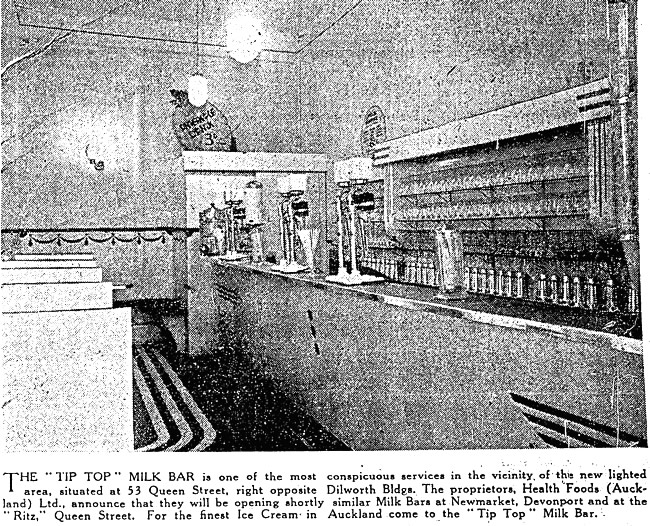
The first Auckland Tip Top Milk Bar, lower Queen Street shopping
feature,
NZ Herald, 28 September 1938
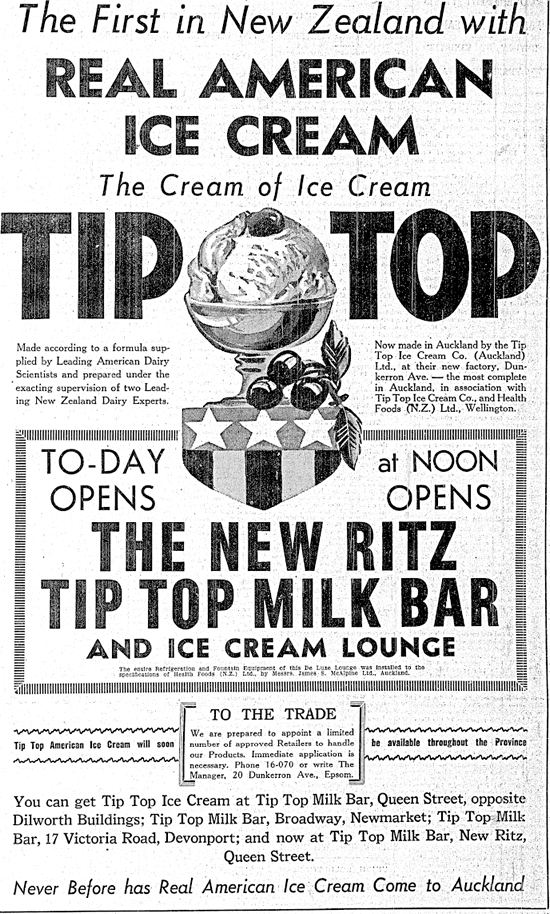
Tip Top Ice Cream and Ritz Tip Top Milk Bar advertisement,
NZ Herald, 16 November 1938
The New Ritz Tip Top Milk Bar sold Kapai Chocolate-covered Bars for
3d each.
As well as Milk Bars, Tip Top sold packaged ice cream through the usual
dairy and grocery outlets. By August 1939, Tip Top already had distribution
depots at Hamilton, Rotorua, Taumaranui and Tauranga.
Interestingly, Tip Top was marketed as "American" or "Real
American" ice cream, made with the "latest American instant
freeze process" and made to "the exclusive and original American
Ice Cream Formula".
Tip Top's by-lines were "Eat Energy!" and "The
Extra Cream Ice Cream".
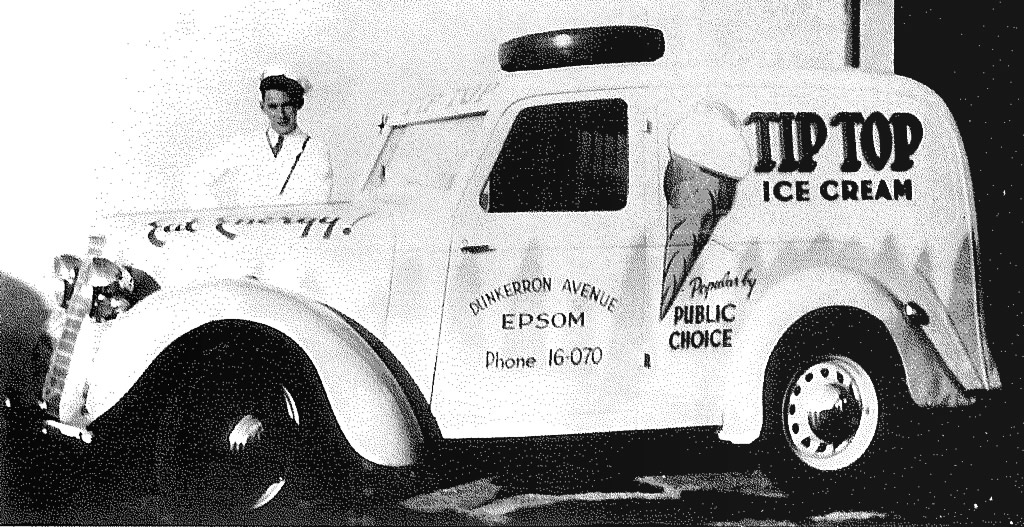
Tip Top Ice Cream Co. Auckland Ltd delivery van, ca. 1939.
- Tip Top archives.
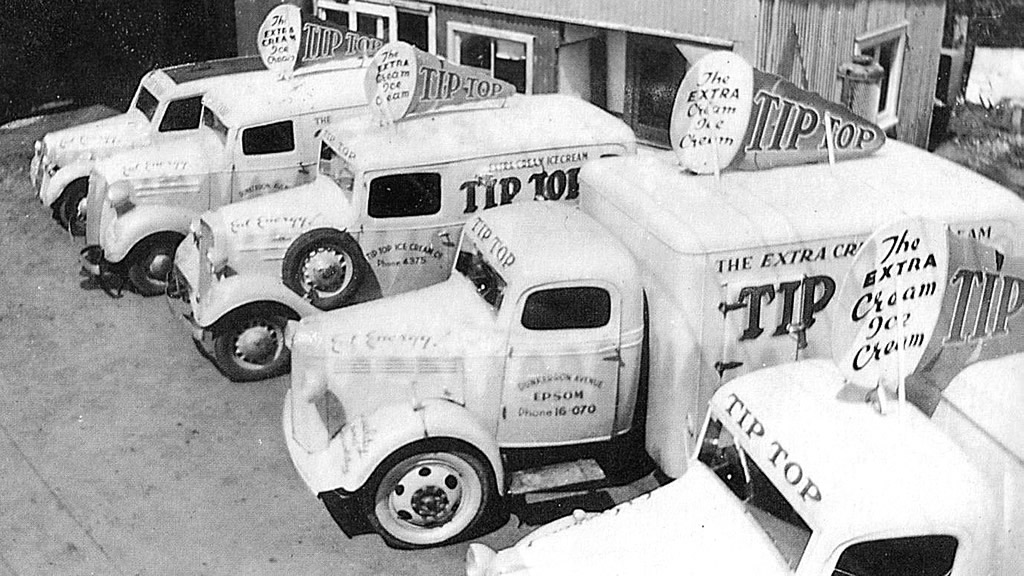
Tip Top Ice Cream Auckland Ltd delivery vans,
ca. 1939.
- Tip Top archives.
In 1939 Len and Bert went to the U.S. to study the
latest methods of manufacture and to purchase new machinery.
One story illustrates how up to date they were already.
While in New York, they were invited to a demonstration of the prototype
of the Anderson Automatic filling machine. They declined, saying that
they had already seen it in operation. The Americans were most surprised,
saying that only two machines had been built, one for demonstration and
the other sent "somewhere down under." Bert and Len gently
explained that the other prototype of the new machine was already working
in the Tip Top factory in Wellington.
In November 1940, Tip Top Auckland ran a "Will-Share" advertising
campaign promoting the sharing of ice cream treats over the summer holidays.
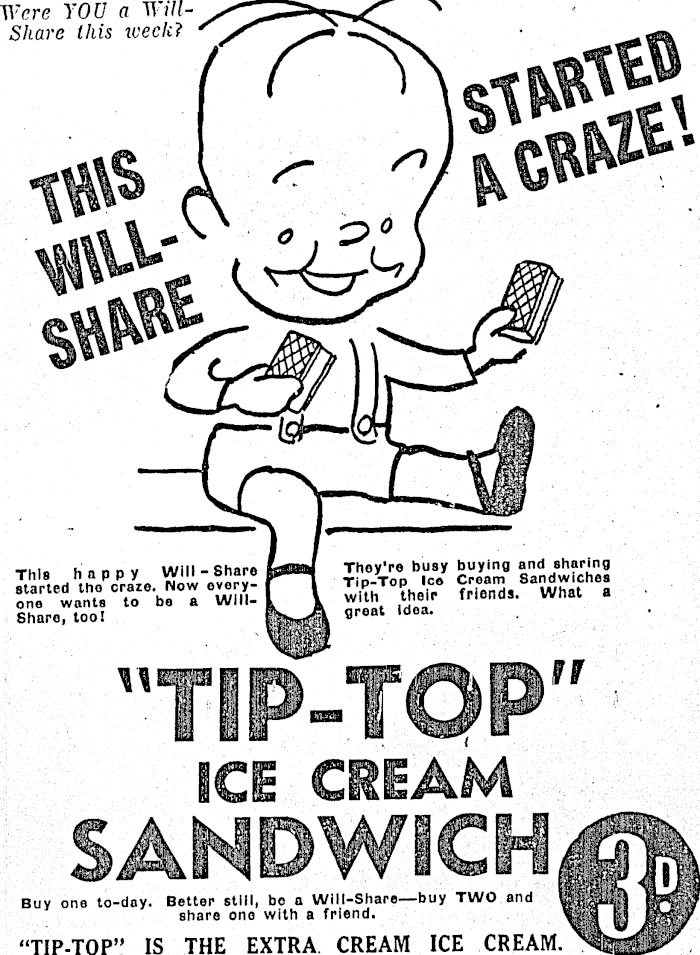
Tip Top Ice Cream Sandwich advertisement, NZ Herald, 23
November 1940
One of the products featured was the Tip Top Ice Cream Sandwich (above)
launched that year and sold for 3d (threepence). It was also referred
to as a Threepenny Slice, the forerunner of today's
Vanilla Slice.
Also featured were Tip Top Threepenny and Sixpenny Cartons, Dixie Cartons
(small waxed cardboard cups sold for 3d each) and a chocolate-covered
ice cream-on-a-stick called a Tippy-Tip, which sold
for 3d and would later become the Topsy.
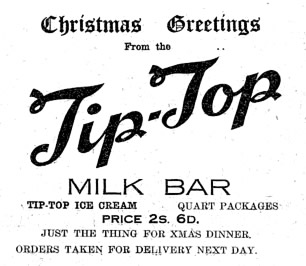
The earliest known use of the scripted Tip Top logo,
Tip-Top Milk Bar Upper Hutt advertisement,
December 1940.
Tip Top Wellington appears to have started to use the classic scripted
version of the "Tip-Top" logo (see
side-bar above) around 1939-1940. Both Wellington and Auckland
companies were also using the block capitals "TIP-TOP" version
around this time, but eventually the scripted version took over. A
hyphen and/or quotation marks were added from time-to-time over the
next 20 years.
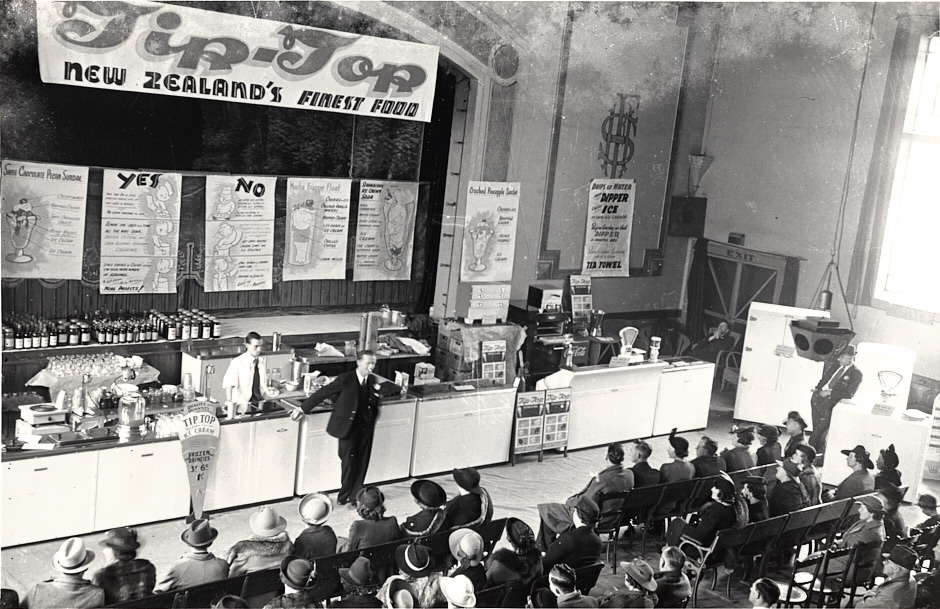
Tip Top sales conference, 1940s. Milk Bar managers and staff
learned about sundaes, floats and sodas, efficient scooping practices
and how to keep dippers ice-free.
With the arrival of the Second World War both Wellington and Auckland-based
chains of Tip Top milk bars began to struggle with distribution and
staff problems. The milk bar side of the business, Health Foods (NZ)
Ltd., was wound down in the early 1940s, although independent Tip Top
milk bars continued to operate around the country.
Sugar restrictions and rationing were imposed in 1942, severely limiting
ice cream manufacturing. Sugar supplies were cut in half; milkfat by
a third.
However by 1944, the large numbers of U.S. servicemen stationed in New
Zealand had stimulated demand and the government began to recognise the
value of ice cream in raising morale.
In November 1944, Tip Top Auckland ice cream mix was
supplied to the Tui Club, a beach rest and recreation centre on Guadalcanal
in the Solomon Islands, where an ice cream plant had been installed for
the use of RNZAF servicemen on leave from the fighting.
It was mentioned in an dvertisement for Tip Top Ice Cream in the Auckland
Star, October 1944:
JUNGLE
FIGHTERS IN ACTION EAT ICE CREAM
One of the recorded strange facts of this war is the authentic
story of jungle fighters in the Solomons enjoying cooling, refreshing
Ice Cream. The Ice Cream mix was supplied by the Tip Top Ice Cream
Company, whose products are so well known to Aucklanders, and was
completed "on the spot" by the Allied canteen authorities. The
comment was made that ''although the fighters achieved both tasks
satisfactorily, licking the Tip Top Ice Cream was a much more enjoyable
matter than licking the foe." Needless to say, both were "licked" thoroughly.
Aucklanders agree that as an energy builder as well as a morale
builder, Tip Top Ice Cream is unequalled.
|
Initially, Len Malaghan had a third of the shareholding of the Auckland
operation and travelled regularly between the two factories. He designed
the original Auckland factory layout and supervised manufacture until
sufficient staff were trained to carry on. Particulars of every mix
were sent to Len in Wellington by telegram and he worked on formulations.
However, as the Auckland business grew, Bert Hayman wanted to raise more
funds for expansion by forming a public company. Len didn't agree, and
they decided to go their separate ways.
Shareholdings were re-arranged so that Len retained the Wellington business,
which stayed a private company, and Bert took over the Auckland business.
1947 - Tip Top Auckland became a Public Company, with
a capital of £105,125.
The two businesses were run quite separately for the next 15 years, although
each retained the Tip Top name and continued to exchange ideas,
new formulas, flavours, plant data and research information.
An agreement was drawn up limiting the Auckland company's activities
to the upper half of the North Island, while the Wellington company could
operate in the lower half of the North Island and the South Island. The
demarcation line was 50 miles north of New Plymouth, north of Waiouru,
and north of Hick's Bay.
Both businesses expanded aggressively through the late 40s and into the
50s.
1949 - Tip Top Auckland was listed on the Stock Exchange.
Tip Top Wellington built a South Island factory in Nelson and had distribution
points set up in Blenheim, New Plymouth, Hawera, Stratford, Wanganui,
Palmerston North, Dannevirke, Hastings, Napier, Waipukurau, Wairoa and
Masterton.
Len was also behind the company's first refrigerated trucking operation
which became Refrigerated Freight Lines Ltd.
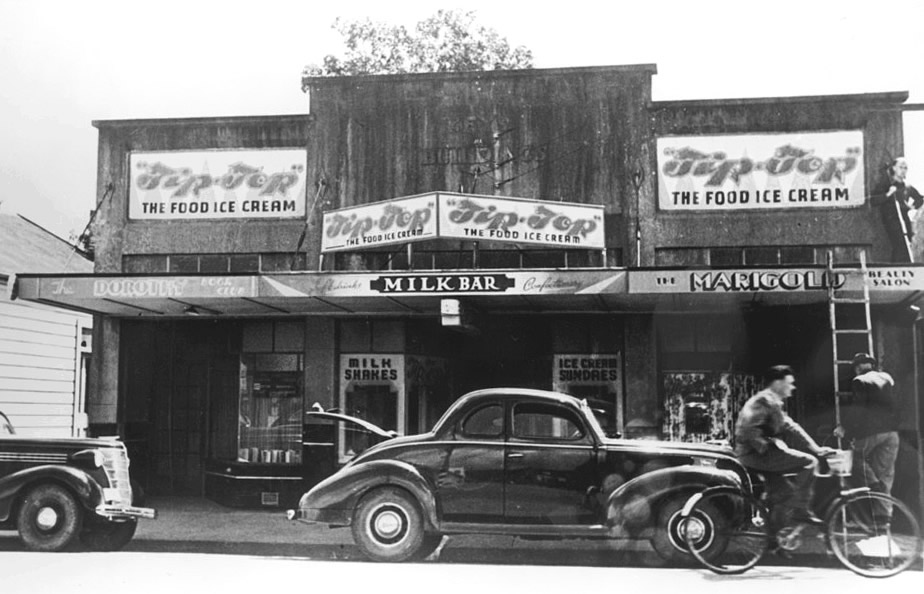
Tip Top Milk Bar, Upper Hutt, 1949.
- Upper Hutt City Library Heritage Collections P3-398-1573.
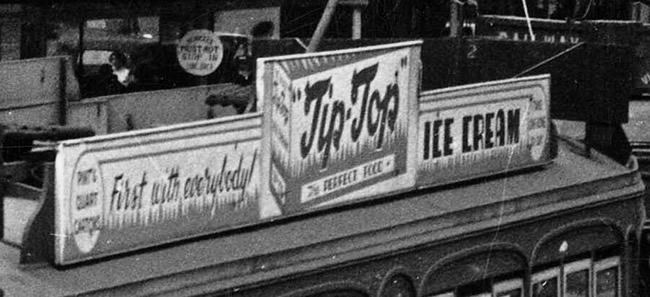
Tip Top advertising on tram, Queen St, Auckland, 1949.
- Alexander Turnbull PAColl-7171-06
In the early 1950s the manufacturing side of both Tip Top businesses
went from strength to strength .

Tip Top (Auckland) staff loading freshly-filled cans of ice cream
into a blast freezer,
Dunkerron Ave., Epsom factory, 1950's.
- Sparrow Industrial Pictures Ltd, Auckland War Memorial
Museum online collection.
Ref. PH-NEG-SP-2914[i].

Tip Top vehicles outside the Dunkerron Ave. factory,
ca. 1948.
- Tip Top archives.
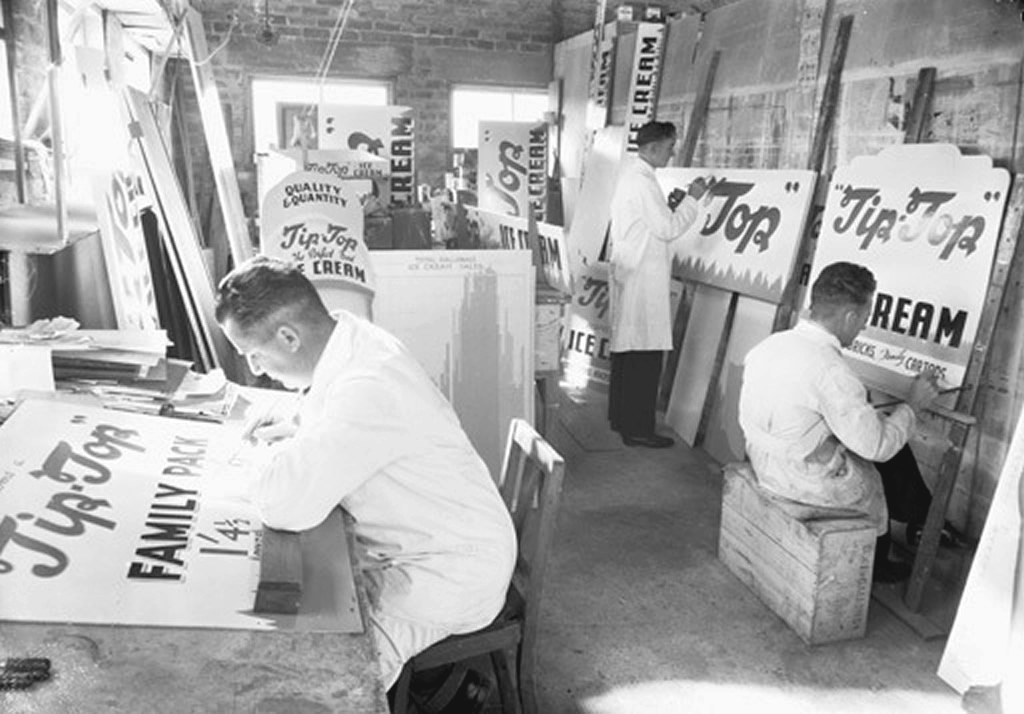
Tip Top (Auckland) signwriters, Dunkerron Ave. factory, 1950's.
- Sparrow Industrial Pictures Ltd, Auckland War Memorial
Museum online collection.
Ref. PH-NEG-SP-2914[iii].
As the two Tip Tops became more efficient and more
powerful, many small producers either went out of business, merged,
or were taken over, absorbed into one or other of the two companies.
The Auckland business was particularly aggressive in pursuing takeovers.
Tip Top became by far the country's largest ice cream brand.
It wasn't just the provinces that Tip Top had in its sights - in 1950
Tip Top Ice Cream Company (Auckland) Ltd, under Bert Hayman, launched
a new ice cream business in Melbourne, Australia, Toppa Ice Cream
Ltd.
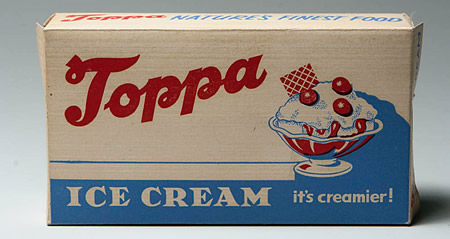
Toppa ice cream carton, 1950s.
- Ephemera Society of Australia Inc.
 More
of the Toppa story ... More
of the Toppa story ...
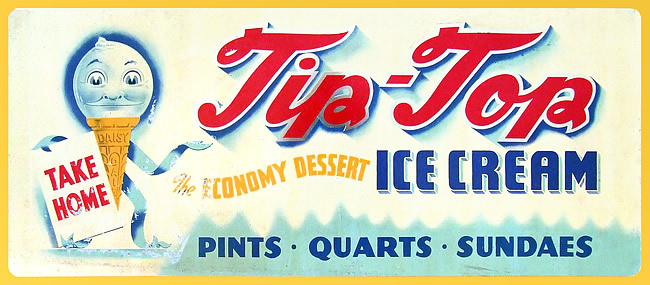
Tip Top Ice Cream steel advertising sign, early 1950s.
The cartoon character was known as "Toppy"; Daisy was the brand
of Daisy Cones Ltd, est. 1948.
- Steve Williams.
1950 - Tip Top Auckland took over Royal
Ice Cream, Thames.
With its greater economies of scale, Tip Top was able to invest in the
technology to produce more sophisticated water ice and ice cream stick
novelties. One of the earliest was the Topsy , a chocolate-coated
vanilla ice cream on a stick, reputedly named after one of Len's favourite
cows.
1951 - the classic Kiwi stick ice cream, the Jelly
Tip was born. Creamy Tip Top vanilla ice cream on a stick, tipped
with a raspberry flavoured jelly, and coated with chocolate, selling
for sixpence.
Tip Top Auckland purchased Frostee ice cream company
in Fiji.
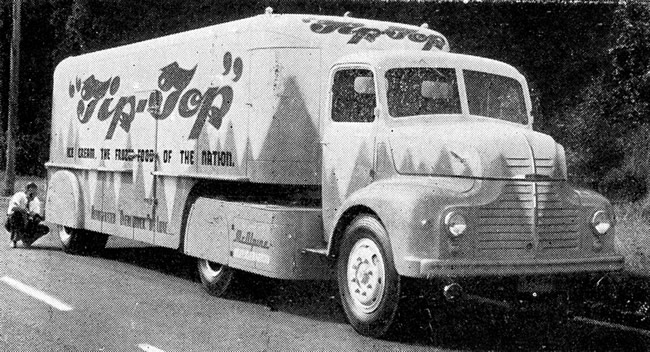
15 ton Leyland truck, refrigeration by McAlpine, 1951.
- Frostee Digest.
1952 - Tip Top Auckland merged with Peters
Ice Cream Co. (N.Z.) Ltd, Auckland.
1953 - Tip Top Auckland merged with the Robinson
Ice Cream Company Ltd, one of its largest Auckland competitors,
and as a result came to own the rights to manufacture the popular Eskimo
Pie.
 Read
more about the Eskimo Pie story. Read
more about the Eskimo Pie story.
In 1953, Tip Top Wellington opened a new factory in
Johnsonville on 4 1/2 acres of freehold land. The processing area was
built to Len Malaghan's own design and featured many innovative technologies
and efficiencies. Freon replaced ammonia in the freezers and churns,
allowing automation of the process, and plate heat exchangers were used
for pasteurisation and ice banks for chilling.
In 1955 a short film was made, "From Cow to Cone: The Tip Top
Story", showing ice cream production inside the Tip Top Wellington
Johnsonville factory.
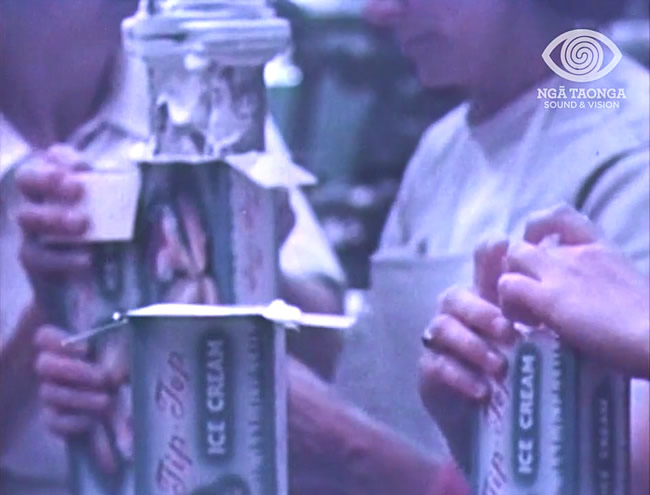
Filling ice cream cartons in the new Tip Top Johnsonville factory.
Still taken from the short film, "From Cow to Cone: The Tip Top
Story", 1955.
- Nga
Taonga Sound & Vision.
At this time Miss Joyce Treloar,
Len's trusted financial advisor, became a shareholder in the Wellington
business.
1954 - Tip Top launched the Strawberry
Toppa - vanilla ice cream on a stick, coated
with a shell of strawberry water ice.
By now Tip Top (Auckland) was operating in North Auckland, Auckland,
Waikato, Victoria, Tasmania, Fiji, Samoa, Niue and Tonga, and was selling
into the Chatham Islands.
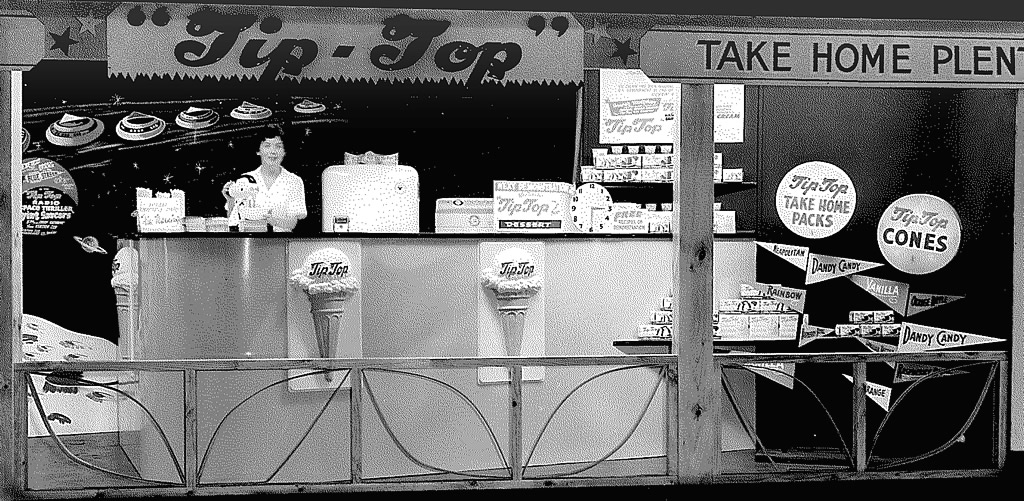
Tip Top display promoting the serialised "radio space thriller" Rocky
Starr , ca. 1955. Flavours shown include Vanilla, Neapolitan, Rainbow,
Orange Ripple, Raspberry Ripple, Dandy Candy.
- Tip Top archives.
1955 - Tip Top launched the TT2 "ice-lolly" on
a stick (ice block). Legend has it that the name 'TT2' came from the
numbering system used for trial recipes in Tip Top's product development
process - TT stood for 'Tip Top', and it was recipe No.2! The original
TT2 expanded into a whole range of stick ices.
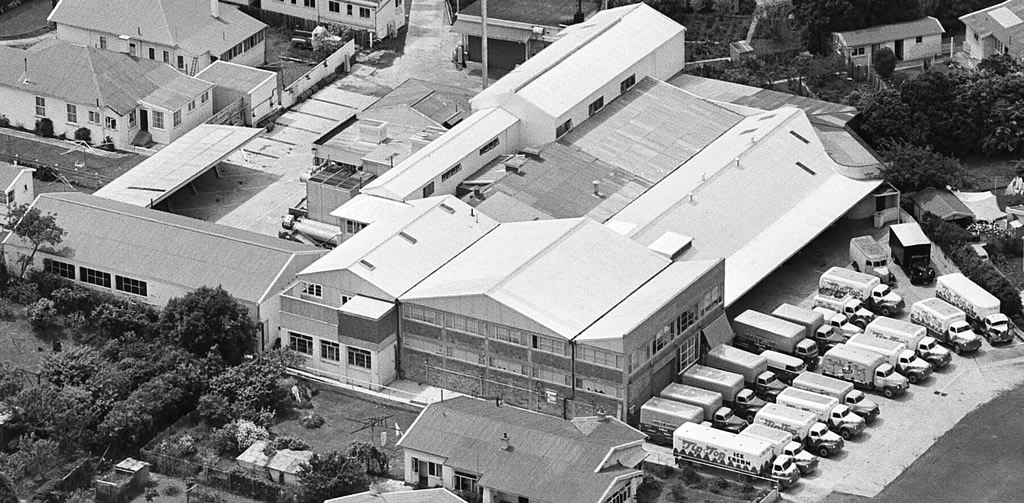
Tip Top Auckland's Dunkerron Ave factory, 1956 (Whites Aviation)
- Alexander Turnbull WA-42756.
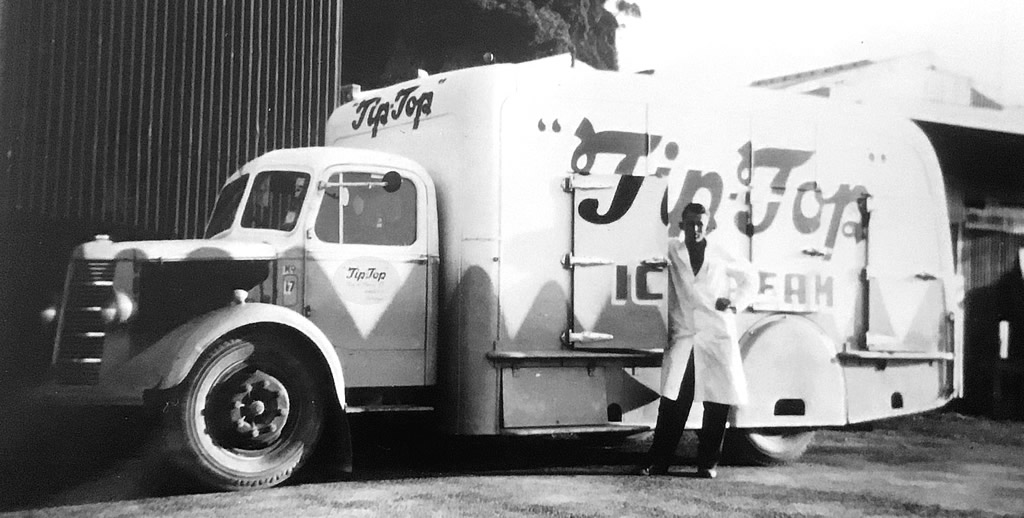
Tip Top van salesman Ray Rinsma on deliveries with truck #17,
Whakatane, 1956.
- Ed Rinsma.
1956 - Tip Top Auckland's frozen
foods subsidiary, General Foods (N.Z.) Ltd. obtained
the rights to distribute Wattie's frozen foods (produced by J. Wattie
Canneries Ltd).
The following year (1957), Tip Top Auckland began merger
discussions with J. Wattie Canneries. (The merger didn't take place until
31 years later, when Tip Top was part of the Goodman Fielder group, which
merged with Watties to form Goodman Fielder Wattie).
1958 - Tip Top Auckland merged with the McDonald
Ice Cream Manufacturing Co. Ltd, based in Hamilton.
1959 - Bert Hayman and his Managing Director Frank
Orr continued their aggressive moves into frozen foods.
Firstly they took over a Nelson frozen vegetable processor Quick
Frozen Foods Ltd. and, later in the year, took a controlling
interest in the Dunedin Ice Cream Manufacturing Co. Ltd (Royal
brand).
Both moves helped expand frozen foods distribution in the South Island
- the latter company owned a Wattie's frozen foods distribution franchise.
A new parent company was set up to cover both ice cream and frozen foods
businesses - General Foods Corporation (New Zealand) Ltd.
General Foods began to sell frozen beans and peas under the Tip Top brand.
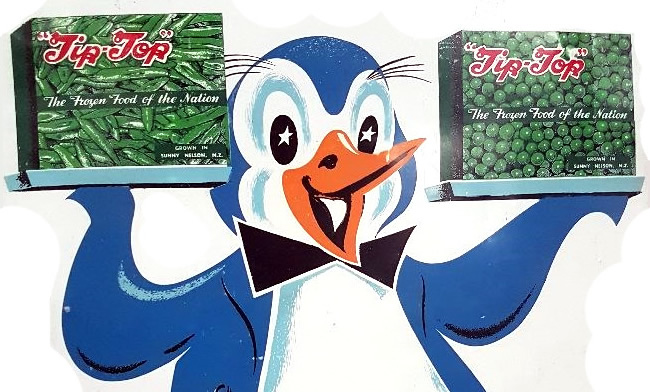
Detail from Tip Top Frozen Foods double-sided metal footpath
sign, ca. 1959.
Packs of Tip Top frozen beans and frozen peas.
"The Frozen Food of the Nation" - "Grown in sunny Nelson, N.Z."
(Ice cream was advertised on the reverse of the sign - " Tip Top
- it's Creamier!") .
- jessiesmum.
1960 - The Auckland company's moves
to expand into the South Island had upset the long-standing territorial
agreement with Tip Top Ice Cream Company (the Wellington-based business),
and created some tension between the two companies. Discussions began
on how to resolve the situation.
The Wellington and Auckland Tip Top ice cream businesses merged on the
1st of May 1960 as part of General Foods Corporation (NZ) Ltd,
which now had Bert Hayman as Chairman, and Len Malaghan as Managing Director.
As well as reuniting the founding partners and their burgeoning businesses,
the merger opened the way to national distribution, which was achieved
within four years.
That same year, General Foods acquired Apex Ice Cream Co. Ltd.,
giving the company a larger South Island manufacturing base, using Apex's
factory at 100 Durham St, Christchurch.
Earlier that year, Apex had merged with Top Notch Delicacies,
Christchurch's third-largest ice cream producer.
1960 - At a cost of £25,000, Tip Top Auckland installed a brand
new Danish Gram fully automated stick novelty machine, the first of its
kind in New Zealand. With seven lanes and multiple options for layers,
dipping, etc., it required continuous feeds of 240 gallons per hour of
pre-frozen mix and produced 12,000 units per hour.
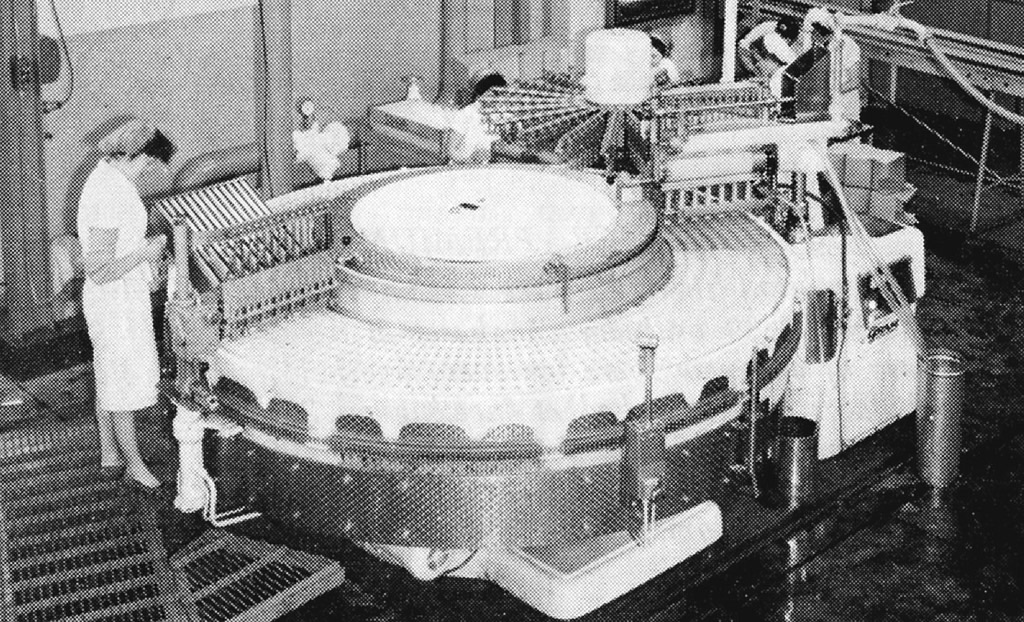
Gram novelty machine, 1960.
- Tip Top archives.
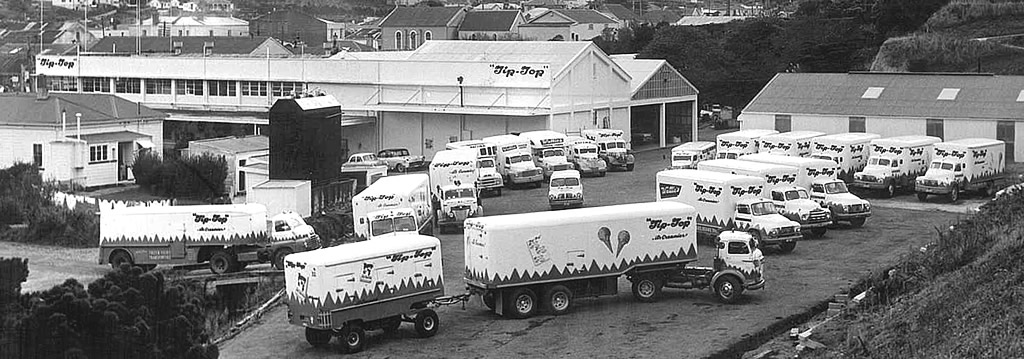
Tip Top Johnsonville factory, ca. 1960.
- Tip Top archives.
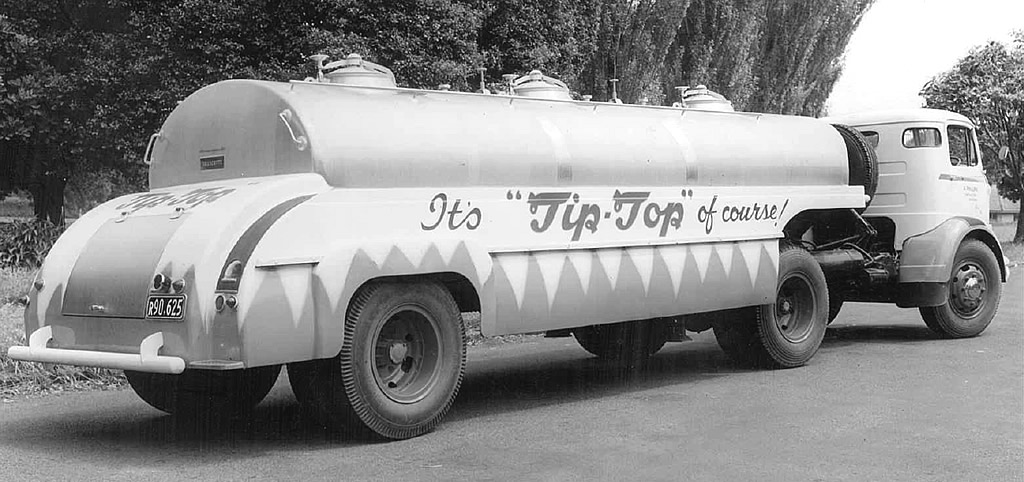
Cream tanker, ca. 1960.
- Tip Top archives.
1961 - General Foods took over the Lucky
Ice Cream Co. Ltd. of Westport.
On 21 April 1961 General Foods opened a new £100,000 Tip
Top Distribution
Centre in Te Rapa, Hamilton with 8,000 square feet of
freezer
space.

Tip Top Distribution Centre, Te Rapa, 1961.
- Helen McLachlan, Old Hamilton & Surrounding
Districts.

Delivery vehicles, New Plymouth depot, 1961.
- Tip Top archives.
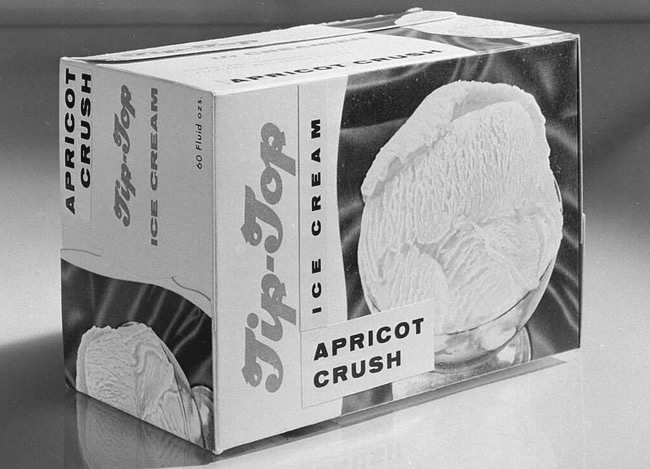
Tip Top TV advertising shot, Apricot Crush Ice Cream take home
pack, 1961.
- Tip Top Ice Cream. K E Niven
and Co: Commercial negatives. Ref: 1/2-213213-F.
Alexander Turnbull Library, Wellington, New Zealand.
|

